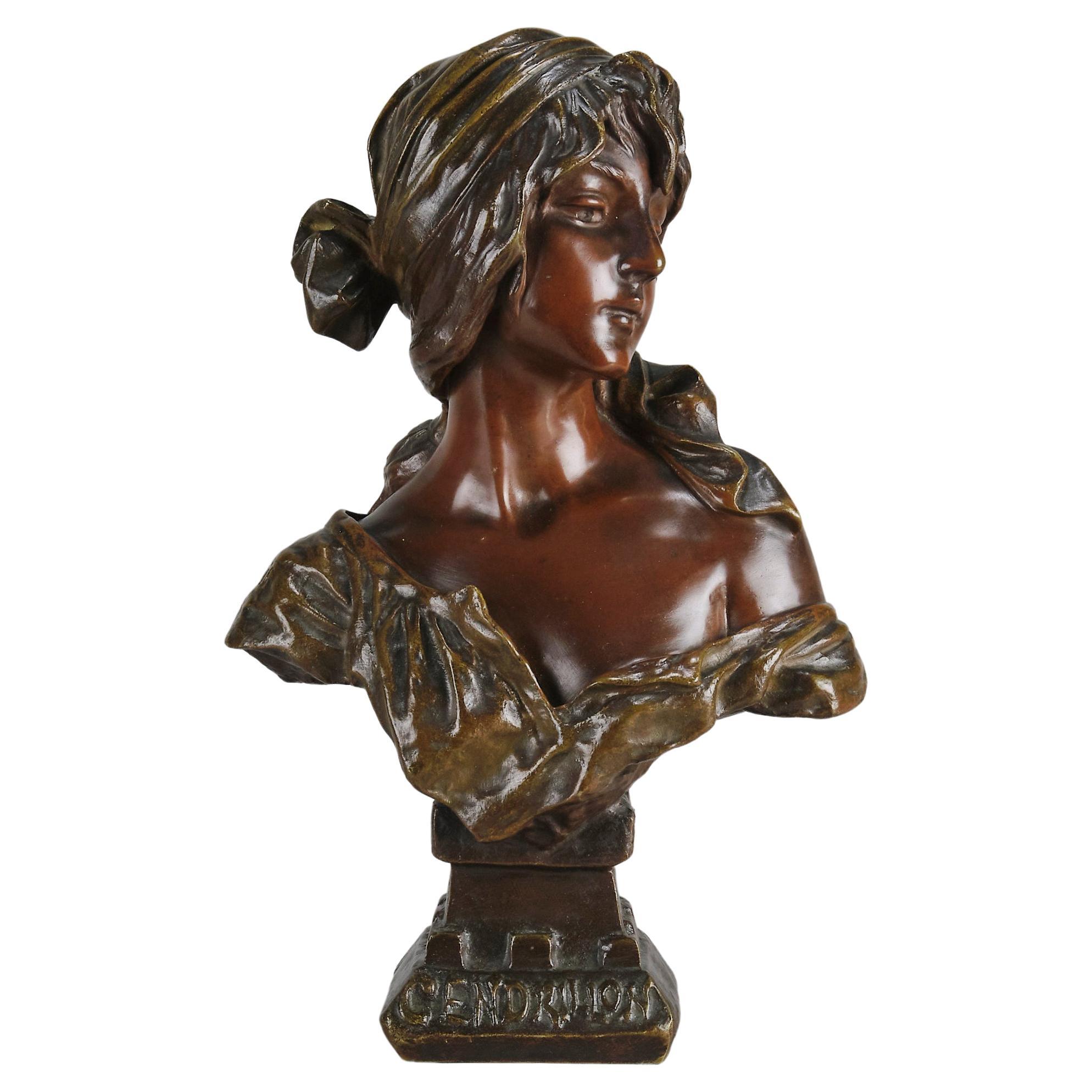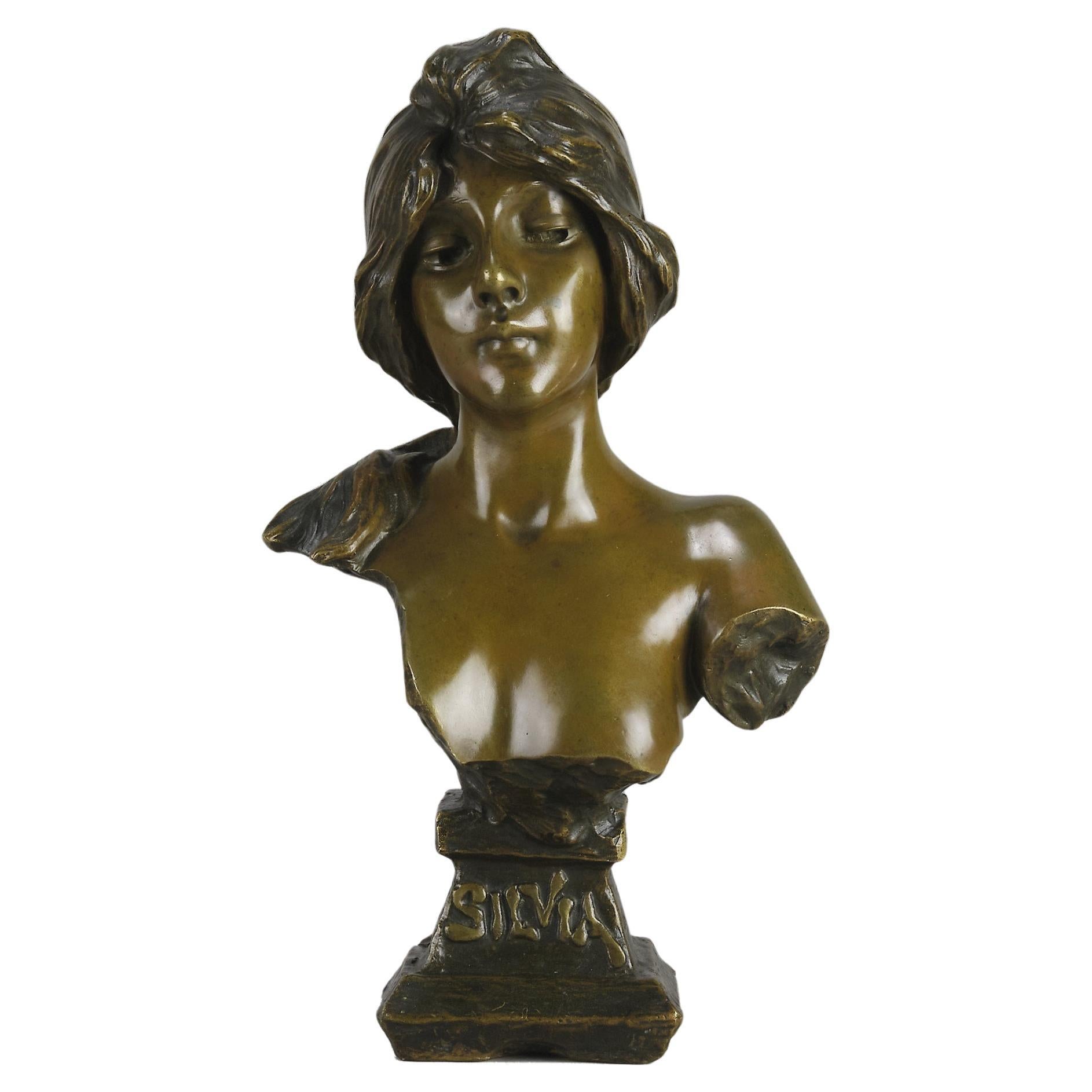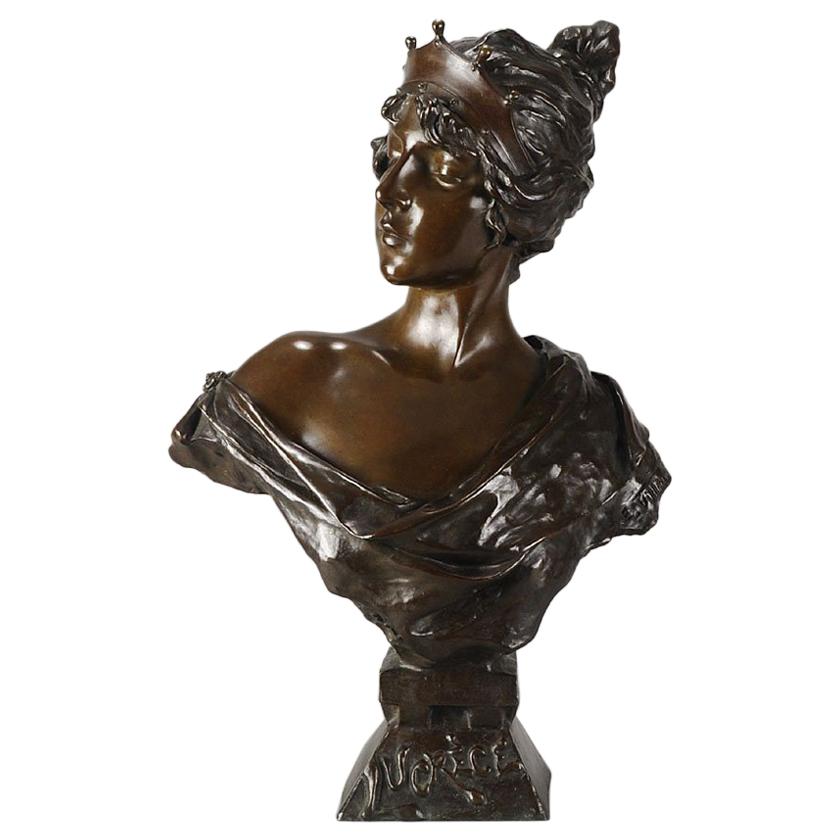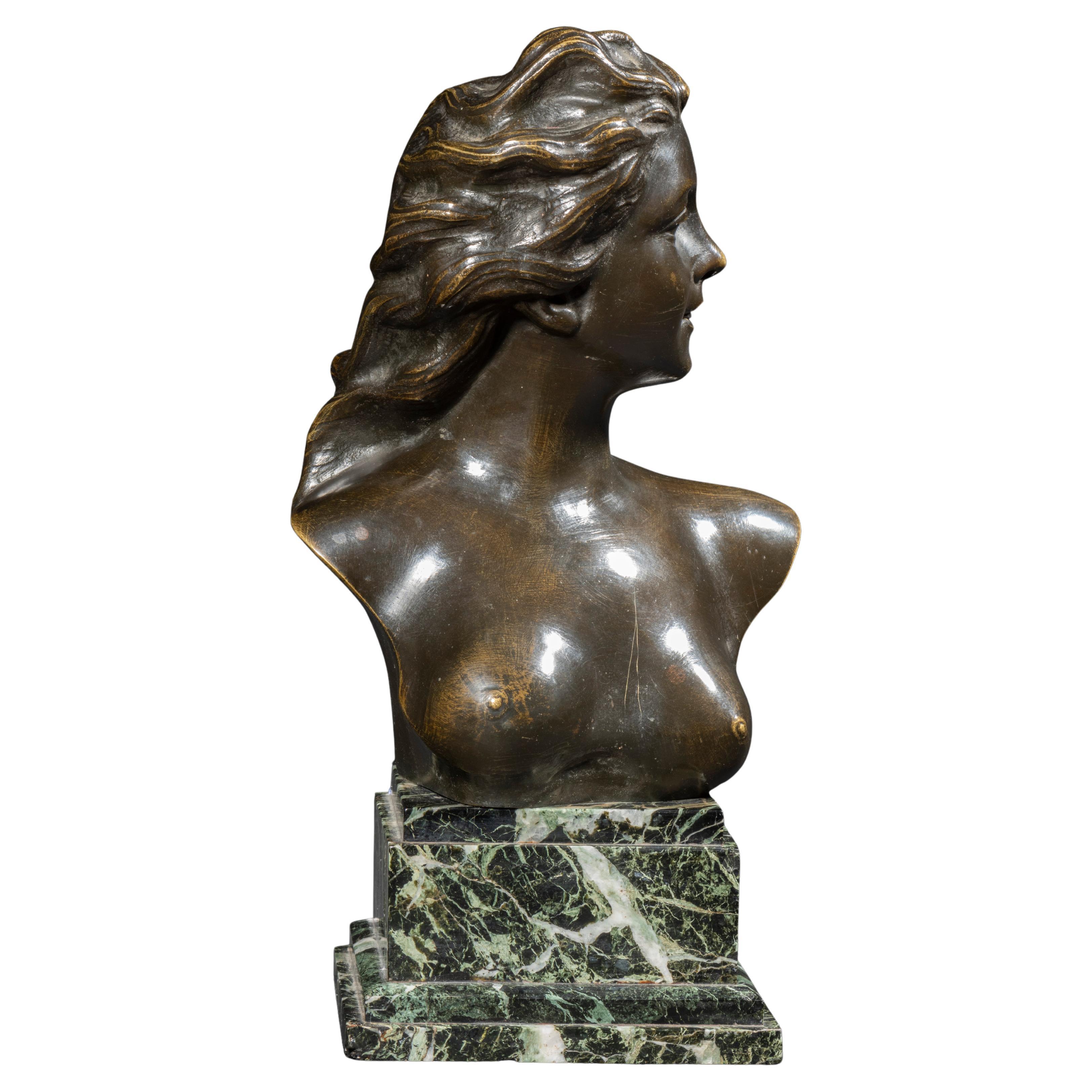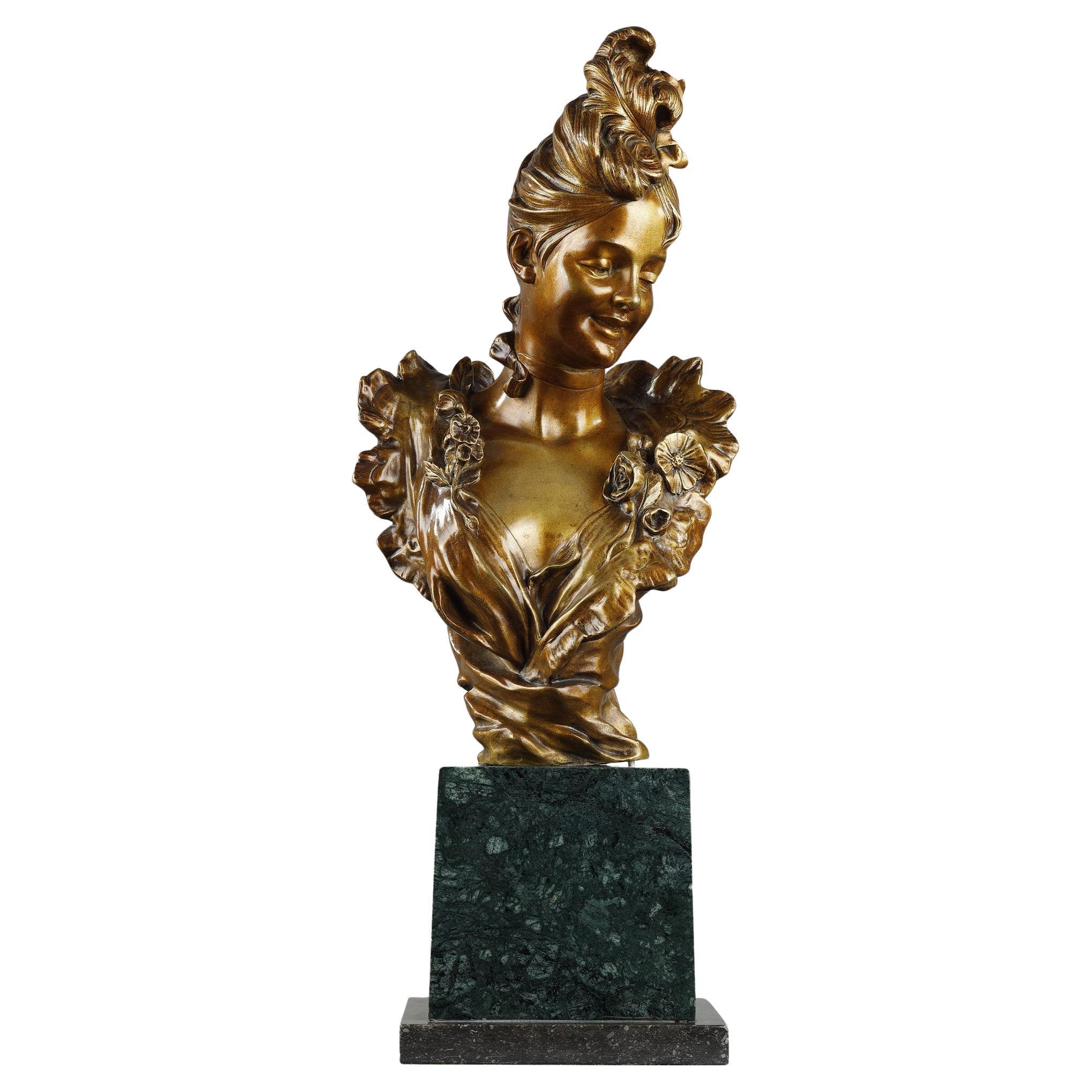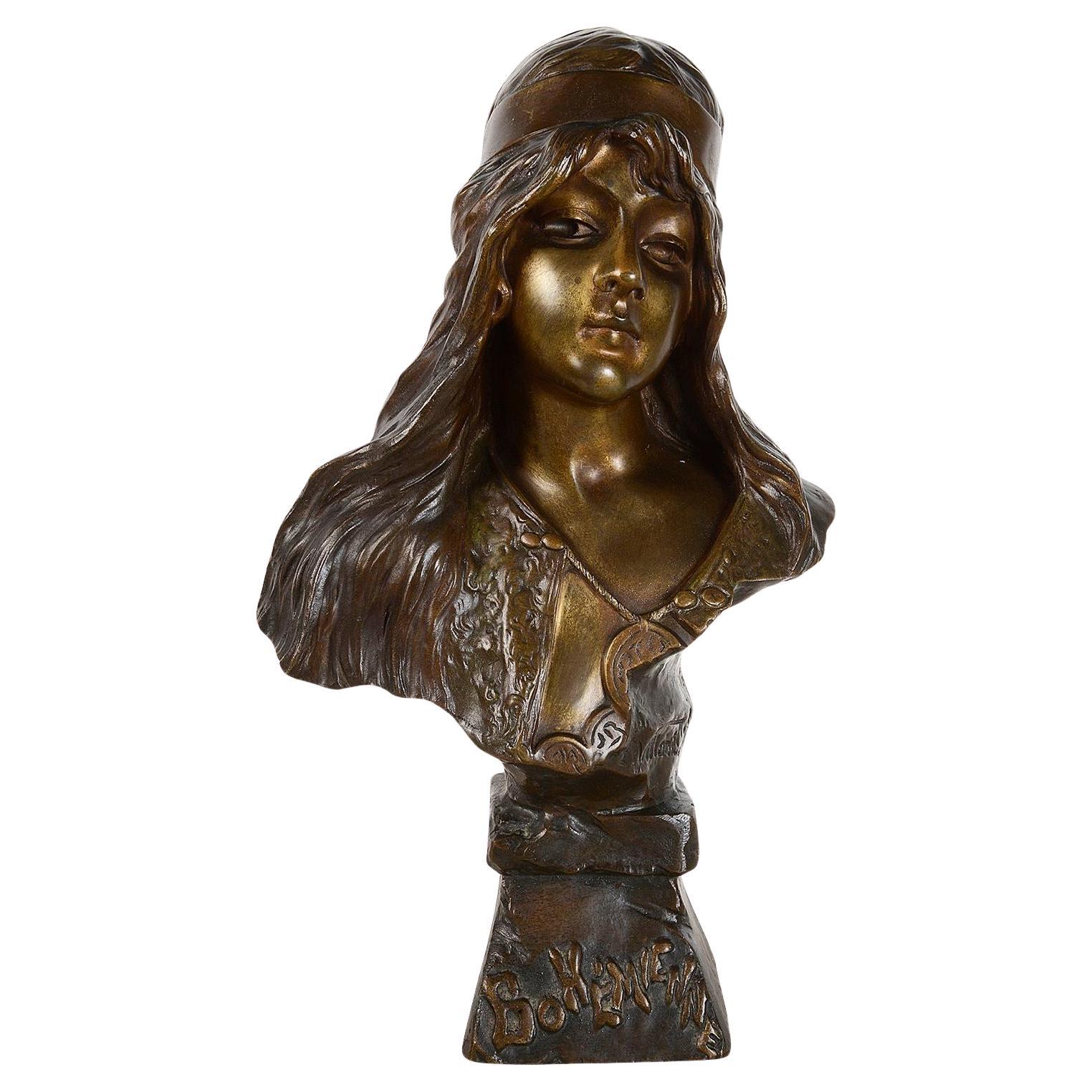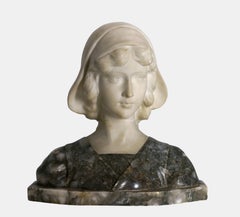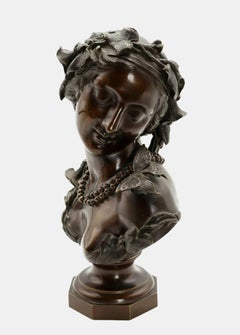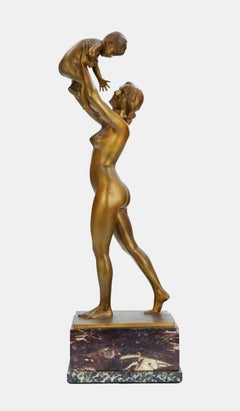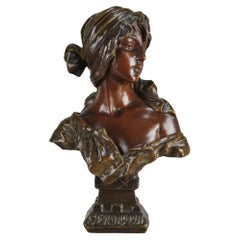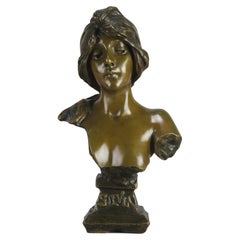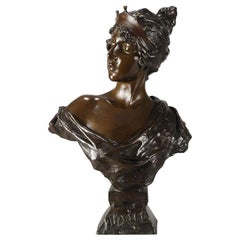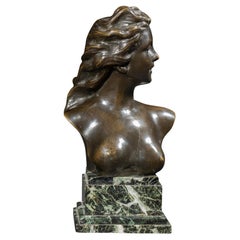Items Similar to Bust of a young woman / - The Opulence of Beauty -
Want more images or videos?
Request additional images or videos from the seller
1 of 13
Anton NelsonBust of a young woman / - The Opulence of Beauty -c. 1890
c. 1890
$782.37
£569.17
€650
CA$1,067.71
A$1,188.99
CHF 618.80
MX$14,660.13
NOK 7,880.95
SEK 7,407.33
DKK 4,946.80
Shipping
Retrieving quote...The 1stDibs Promise:
Authenticity Guarantee,
Money-Back Guarantee,
24-Hour Cancellation
About the Item
Anton Nelson (i.e. Antoine Joseph van den Kerckhoven) (1849 Brussels - after 1910 ibid.), Bust of a young woman, c. 1890. Patinated bronze on cast base, 30 cm (total height) x 20 cm (width) x 14 cm (depth), weight 2.5 kg. Signed “Ant.[on] Nelson” on the reverse.
- Somewhat stained and rubbed, blackened edge of the cape on the reverse, outer tip of the robe with a hairline crack. Overall still in good condition for its age.
- The Opulence of Beauty -
The youthful beauty gazes confidently into the distance, looking forward to her future. Beneath her graceful face is her gracefully elongated neck, which flows into her bare shoulders. And the garment underneath reveals more than it conceals. The youthful, natural nakedness is surrounded by an opulent accessory that adorns her like an ornament. The cape-like drapery forms a flower shape from which the youthful beauty seems to grow, while the headdress completes the flower shape at the top.
GERMAN VERSION
Anton Nelson (d.i. Antoine Joseph van den Kerckhoven) (1849 Brüssel - nach 1910 ebd.), Büste einer jungen Frau, um 1890. Patinierte Bronze auf gegossenem Sockel, 30 cm (Gesamthöhe) x 20 cm (Breite) x 14 cm (Tiefe), Gewicht 2,5kg. Rückseitig mit „Ant.[on] Nelson“ signiert.
- Etwas fleckig und berieben, rückseitige Kante des Umhangs geschwärzt, äußere Spitze des Gewandes mit Haarriss. Insgesamt in einem altersgemäß noch guten Zustand.
- Die Opulenz der Schönheit -
Selbstbewusst blickt die jugendliche Schönheit in die Ferne, die für ihre noch offene Zukunft einsteht. Unter dem anmutigen Antlitz ist ihr grazil gelängter Hals zu sehen, der in die entblößten Schultern übergeht. Und das Gewand darunter enthüllt ihren Körper mehr als das es ihn verbirgt. Die jugendlich-natürliche Blöße wird von einem opulenten Beiwerk umgeben, das sie wie ein Ornament schmückt. Der umhangartige Überwurf bildet eine Blütenform, aus der die jugendliche Schönheit hervorzuwachsen scheint, während der Kopfschmuck die Blütenform nach oben vollendet.
- Creator:Anton Nelson (1849 - 1910, American)
- Creation Year:c. 1890
- Dimensions:Height: 11.82 in (30 cm)Width: 7.88 in (20 cm)Depth: 5.52 in (14 cm)
- Medium:
- Movement & Style:
- Period:
- Condition:680.
- Gallery Location:Berlin, DE
- Reference Number:1stDibs: LU2438215416672
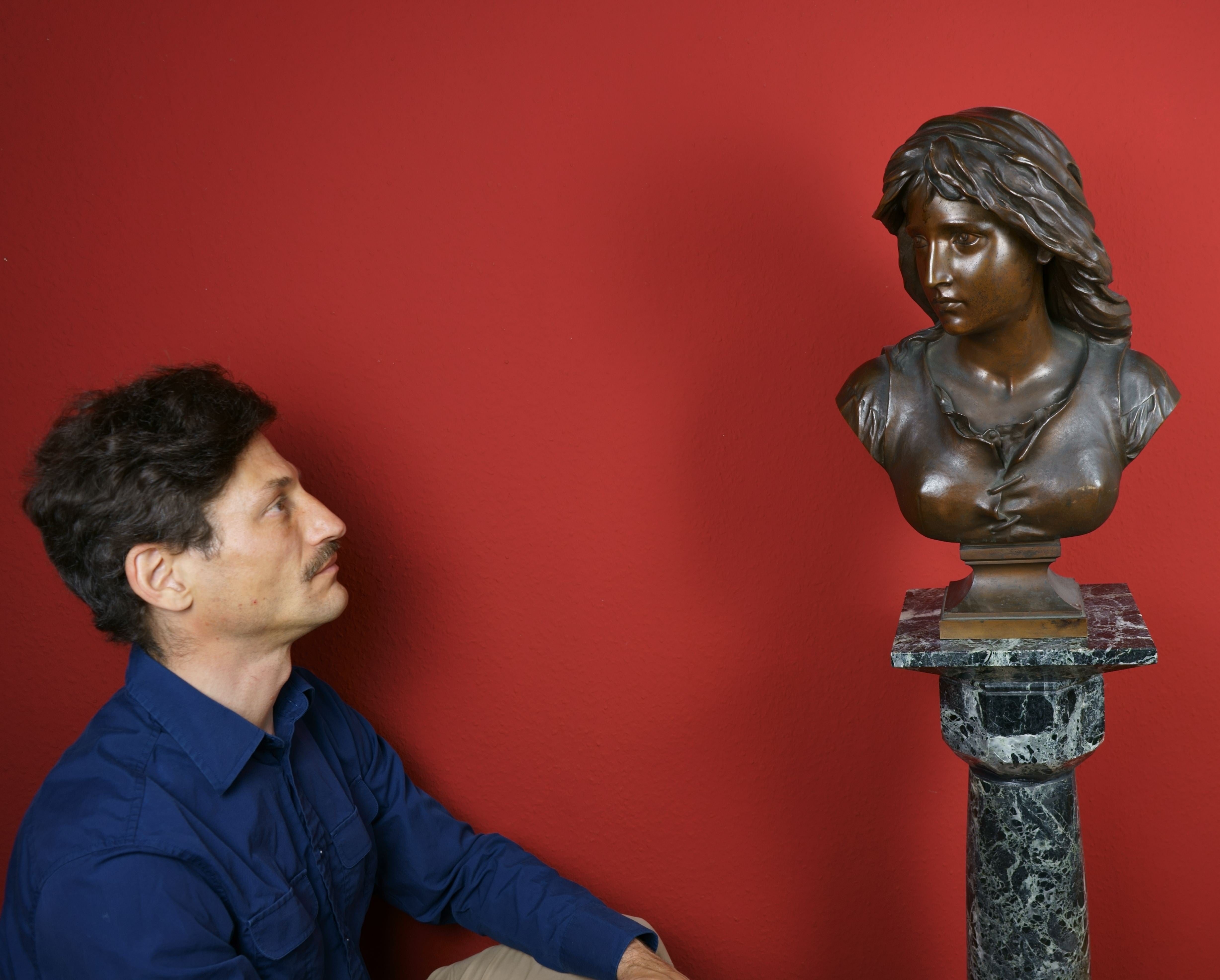
About the Seller
5.0
Gold Seller
Premium sellers maintaining a 4.3+ rating and 24-hour response times
Established in 2014
1stDibs seller since 2023
19 sales on 1stDibs
Typical response time: 5 hours
- ShippingRetrieving quote...Shipping from: Berlin, Germany
- Return Policy
Authenticity Guarantee
In the unlikely event there’s an issue with an item’s authenticity, contact us within 1 year for a full refund. DetailsMoney-Back Guarantee
If your item is not as described, is damaged in transit, or does not arrive, contact us within 7 days for a full refund. Details24-Hour Cancellation
You have a 24-hour grace period in which to reconsider your purchase, with no questions asked.Vetted Professional Sellers
Our world-class sellers must adhere to strict standards for service and quality, maintaining the integrity of our listings.Price-Match Guarantee
If you find that a seller listed the same item for a lower price elsewhere, we’ll match it.Trusted Global Delivery
Our best-in-class carrier network provides specialized shipping options worldwide, including custom delivery.More From This Seller
View AllBust of a young woman / - Beauty of youth -
Located in Berlin, DE
Anonymous, Bust of a young woman, c. 1900, artificial marble and gray onyx marble. 37 cm (height) x 37 cm (width) x 22 cm (depth), weight 17.2 kg. Signed “GURRINI” on the reverse.
-...
Category
Early 1900s Realist Figurative Sculptures
Materials
Marble
$914 Sale Price
20% Off
Psyche / - Fulfilled longing -
Located in Berlin, DE
Jan Jozef Jaquet (1822 Antwerp - 1898 Brussels), Psyche, 1847. Black-brown and brown patinated bronze on a cast base. 30 cm (height) x 22 cm (width) x 12 cm (depth), weight 5 kg. Ver...
Category
1840s Realist Figurative Sculptures
Materials
Bronze
$1,444 Sale Price
20% Off
Reading Woman / - The golden glow of imagination -
By Albert-Ernest Carrier-Belleuse
Located in Berlin, DE
Albert-Ernest Carrier-Belleuse (1824 Anizy-le-Château - 1887 Sèvres), Reading Woman, around 1880. Polished bronze mounted on a cast base. 33 cm (total height) x 9 cm (length) x 9 cm ...
Category
1880s Realist Figurative Sculptures
Materials
Bronze
$2,311 Sale Price
20% Off
Mother Happiness / - The ecstasy of maternal joy -
Located in Berlin, DE
Johannes Boese (1856 Ostrog - 1917 Berlin), Mutterglück, um 1910. Goldbraun patinierte Bronze auf gegossener rechteckiger Plinthe, montiert auf zweifarbigem Marmorsockel (9,5 cm Höhe...
Category
1910s Art Nouveau Nude Sculptures
Materials
Bronze
$4,044 Sale Price
20% Off
The Feeding / - Natural grace -
Located in Berlin, DE
Erich Schmidt-Kestner (1877 Berlin - 1941 Nordhausen), The Feeding, around 1915. Gold and black patinated bronze with cast brown patinated plinth mounted on a lightly veined black-gr...
Category
1910s Art Nouveau Nude Sculptures
Materials
Bronze
$4,333 Sale Price
20% Off
Florentine singer / - The Renaissance of the Renaissance -
By Paul Dubois
Located in Berlin, DE
Paul Dubois (1829 Nogent-sur-Seine - 1905 Paris), Florentine singer, 1865. Light brown patinated bronze with cast round plinth mounted on a square marble base (3.5 cm high). Total height 53 cm. Bronze dimensions: 49.5 cm (height) x 20 cm (length) x 10 cm (width), weight 5.6 kg. Inscribed on the plinth "P.[aul] DUBOIS", dated "1865", with the foundry's mark "F. BARBEDIENNE FONDEUR" and the signet "REDUCTION MECANIQUE A. COLLAS".
- Patina very occasionally darkened, lute with loss of one tuning peg, otherwise in excellent condition.
- The renaissance of the Renaissance -
The bronze is a precisely executed and masterfully cast contemporary reduction of Paul Dubois 155 cm tall masterpiece "Florentine Singer", which is exhibited in the Musée d'Orsay and for which the artist was awarded the Medal of Honor at the Paris Salon in 1865. The work acted as a beacon, and was followed by a plethora of depictions of juveniles.
Inspired by Donatello and Luca della Robbia, but also by painters such as Piero della Francesca, Benozzo Gozzoli, and Pinturicchio, the "Florentine Singer" is not an epigonal work that pays homage to a vanished era, but a successful attempt to draw vitality from the art of the past and thus give it new life.
The effect of vitality is the core of Italian Renaissance art theory. In order to fulfill itself as art, art had to appear like nature. This naturalism also characterizes the "Florentine Singer". The young man appears to have been taken from life, which is reinforced by the momentary nature of his action. He has just struck a now fading chord. In addition, the natural appearance is enhanced by the detailed shaping of the figurative details, such as the laces with the slightly curved leather of the shoes, the belt buckle, or the ornamentation on the body of the lute. Even the fingernails are clearly defined. Unlike the Renaissance, however, the effect of liveliness here is not based on the "discovery" of nature and the human body, but primarily on the rediscovery of the art of the Quattrocento. The liveliness of the artwork is therefore at the same time a revitalization of this art, so that we can speak of a Renaissance of the Renaissance, just as the Pre-Raphaelites in England at the same time transferred the Quattrocento to contemporary art.
Dubois takes on the most difficult of all subjects, the depiction of singing through silent sculpture. He was preceded in this by Luca della Robbia and Donatello with their pulpits of singers created in the 1430s in the Museo dell'Opera del Duomo in Florence. Compared to these works, the physiognomy of Dubois singer is far less animated, yet he also depicts singing in a convincing manner. He uses the whole body. He takes the ancient contrapposto, which was essential to Renaissance sculpture, and transforms the standing leg-playing posture into a late medieval S-swing, giving the body an elegant beauty and at the same time setting it in melodic motion. In the equally elegant finger position, the music is expressed in a much more literal way with the beating of the lute. Finally, the musicality of the sculpture culminates in the face with the mouth open to sing.
Through the act of singing, which is a great challenge to the artistic will to depict perfect beauty, the gracefulness of the classical face is not diminished, but enhanced. Starting from the face with the singing mouth and the gaze absorbed by the sounds, the inner vitality spreads, giving the bronze sculpture an intense aura, enhanced by the music. Dubois transfers the beauty of the Renaissance to the musical, sublimating the visible sculpture to the invisible of music.
He took up the challenge of transcending the Renaissance with the Renaissance, thus responding to the Querelle des Anciens et des Modernes, which arose at the end of the 17th century around the French Academy and remained virulent into the 19th century, in which antiquity was regarded either as an unattainable ideal or as a standard to be surpassed. With his work, Dubois proved that the Renaissance, which had championed the art of the ancients, could lead to a new renaissance of art.
About the artist
Paul Dubois' great-uncle was the famous French Baroque sculptor Jean-Baptiste Pigalle, in whose footsteps the talented great-nephew followed. When he debuted at the Paris Salon in 1858, he signed his work "Dubois-Pigalle". At his father's request, however, he first studied law before devoting himself to sculpture under the tutelage of François Christophe Armand Toussaint in 1856 and entering the École des Beaux-Arts in 1858. From 1859 to 1863, he lived in Rome and traveled to Naples and Florence. Inspired by Florentine art of the quattrocento, Dubois initiated a school-forming neo-Florentine style that combined the elegantly simple forms of youthful grace with a precise wealth of detail.Two purchases by the French state (“envois de Rome”) were made during his stay in Rome, which brought him recognition in Paris. After his return there, he quickly became an internationally sought-after artist.
Dubois was also active as a creator of monuments. His most famous work is the equestrian statue of Joan of Arc (1896) on the forecourt of Reims Cathedral. He was also a sought-after portraitist who produced around 50 busts and - Dubois was also a passionate painter - around 100 portraits in oil.
From 1873 to 1878 he was curator of the Museum du Luxembourg, in 1876 he became a member of the Institut de France and from 1878 to 1905 he was director of the École des Beaux-Arts.
In 1865, Dubois was awarded the Paris Salon Medal of Honor for his “Florentine Singer”. In 1867 he became Chevalier, in 1874 Officier, in 1886 Commandeur of the Légion d'honneur, which awarded Dubois the Grande Croix in 1896.
Selected Bibliography
Stole, Elmar: Paul Dubois. In: Saur. Allgemeines Künstlerlexikon, vol. 30, Munich - Leipzig 2001, pp. 677-678.
GERMAN VERSION
Paul Dubois (1829 Nogent-sur-Seine - 1905 Paris), Florentinischer Sänger, 1865. Hellbraun patinierte Bronze mit gegossener runder Plinthe auf quadratischem Marmorsockel montiert (3,5 cm Höhe). Gesamthöhe 53 cm. Maße der Bronze: 49,5 cm (Höhe) x 20 cm (Länge) x 10 cm (Breite), Gewicht 5,6 kg. Auf der Plinthe mit „P.[aul] DUBOIS“ bezeichnet, auf „1865“ datiert, mit dem Gießereistempel „F. BARBEDIENNE FONDEUR“ und dem Signet „REDUCTION MECANIQUE A. COLLAS“ versehen.
- Patina sehr vereinzelt nachgedunkelt, Laute mit Verlust eines Stimmwirbels, ansonsten ausgezeichnet erhalten.
- Die Renaissance...
Category
1860s Realist Figurative Sculptures
Materials
Bronze
$4,333 Sale Price
20% Off
You May Also Like
Late 19th Century Art Nouveau Bust Entitled "Cendrillon" by Emmanuel Villanis
By Emmanuel Villanis
Located in London, GB
An attractive late 19th Century Art Nouveau French bronze bust exhibiting deep multi-hued patination and excellent detail. The beautiful character wearing a head dress and a loosely draped blouse representing ’Cinderella’ from the famous French opera. The bronze is signed E Villanis and titled to the fore on its integral bronze base.
ADDITIONAL INFORMATION
Height: 30 cm
Width: 19 cm
Depth: 12 cm
Condition: excellent original condition
Circa: 1890
Materials: Bronze
Book Ref: Emmanuel Villanis by Josje Hortulanus-de Mik
Page No: 35
SKU: 8773
ABOUT
Villanis Cendrillon
Emmanuel Villanis was an industrious man. He is believed to have created some 200 to 250 pieces. His oeuvre pre-eminently consisted of busts and full body statues...
Category
Antique 19th Century French Art Nouveau Figurative Sculptures
Materials
Bronze
Late 19th Century Art Nouveau Bust entitled "Silvia" by Emmanuel Villanis
By Emmanuel Villanis
Located in London, GB
A very fine late 19th century French bronze bust of an attractive classical maiden modelled in the Art Nouveau style, with fabulous multi hued patination of brown and a subtle green, accentuating the excellent hand finished detail. Signed E Villanis, with Societe des Bronzes foundry seal, numbered and with raised title to the fore.
ADDITIONAL INFORMATION
Height: 28 cm
Width: 16 cm
Depth: 10 cm
Condition: Excellent Original Condition
circa: 1890
Materials: Bronze
Book Ref: Emmanuel Villanis by Josje Hortulanus-de Mik
Page No: 79
SKU: 8775
ABOUT
Sylvia Ballet - Silvia
Sylvia, (the spelling is different in french) is a classical ballet. It features a nondescript mythical setting and a late nineteenth-century score, in which it's themes correlate to giving it a more classical feel, however, it was quite revolutionary for its time. The score was and still is recognized for its greatness. Delibes' work is certainly the best appreciated aspect of the ballet for its innovation, creativity, and maturity. Frederick Ashton's choreography complements the music very well in this respect, staying true to the spirit of the original production while incorporating modern techniques and adding his own unique touch.
The ballet itself follows Sylvia who is a loyal follower of Diana (the goddess of the hunting and chassitity). The story starts with Sylvia being stalked by the diety Eros. When she discovers this they fire their bows at each other respectively. However only Eros's shot is true and wounds Sylvia. This is where she is kidnapped by an unknown assailant later revealed to be Orion.
Sylvia escapes the caves of Orion by getting her captor intoxicated and pleading to Eros to rescue her. When he begrudgingly rescues her he takes her to the temple of Diana where her love awaits. This leads her to repeal her oath of Chassity taken as a follower of Diana.
Emmanuel Villanis
Emmanuel Villanis was an industrious man. He is believed to have created some 200 to 250 pieces. His oeuvre pre-eminently consisted of busts and full body statues. Most of these were manufactured in bronze, but there are also models in white metal and terra cotta. Different patinas were used. The bronzes were mainly cast by the Societé de Bronzes de Paris and can be recognised by the round stamp...
Category
Antique Late 19th Century French Art Nouveau Busts
Materials
Bronze
Art Nouveau Bronze Bust "Lucrece” by E Villanis
By Emmanuel Villanis
Located in London, GB
A entrancing late 19th century French Art Nouveau bronze bust entitled ‘Lucrece’, of a beautiful classical lady modeled in the Art Nouveau style with excellent rich brown variegated patina and smooth tactile surface detail. Signed E Villanis...
Category
Antique Late 19th Century French Art Nouveau Busts
Materials
Bronze
JEF LAMBEAUX (1852-1908) "Bust of a Young Woman" in bronze
By Jef Lambeaux
Located in Ixelles, BE
JEF LAMBEAUX (1852-1908) "Bust of a Young Woman" in bronze.
Jef Lambeaux's "Bust of a Young Woman" with bared breasts is a striking work of art that embodies both beauty and controversy. Created by the eminent Belgian sculptor Jef Lambeaux (1852-1908), this bronze sculpture reveals exceptional technical mastery and extraordinary artistic sensitivity. The young woman depicted, with her hair flowing freely and her face imbued with serenity, embodies the quintessence of feminine beauty.
This work is part of the Romantic Realism...
Category
Antique Late 19th Century Belgian Art Nouveau Busts
Materials
Bronze
Bust of a young woman from the Belle-époque, by Victor Léopold Bruyneel
By V. Bruyneel
Located in Paris, FR
Bust of a young woman from the Belle Epoque period, in bronze with a golden patina, resting on a green Alpine marble pedestal on a grey sainte Anne counter pedestal. The smiling youn...
Category
Antique Early 1900s French Art Nouveau Busts
Materials
Marble, Bronze
Bronze bust of a Bohemian young girl, 1920
Located in Brighton, Sussex
Enchanting patinated bronze bust of a young Bohemian girl.
Batch 81 G340/24 DNYZ
Category
Early 20th Century French Art Nouveau Abstract Sculptures
Materials
Bronze
